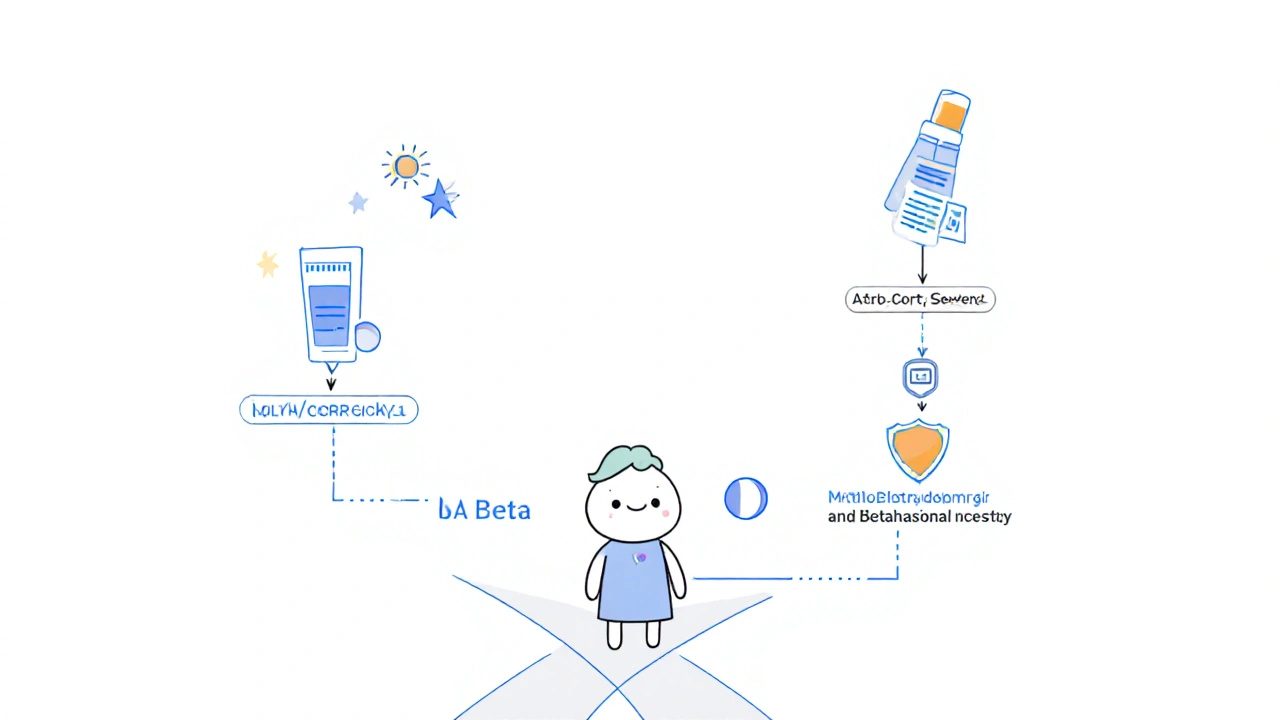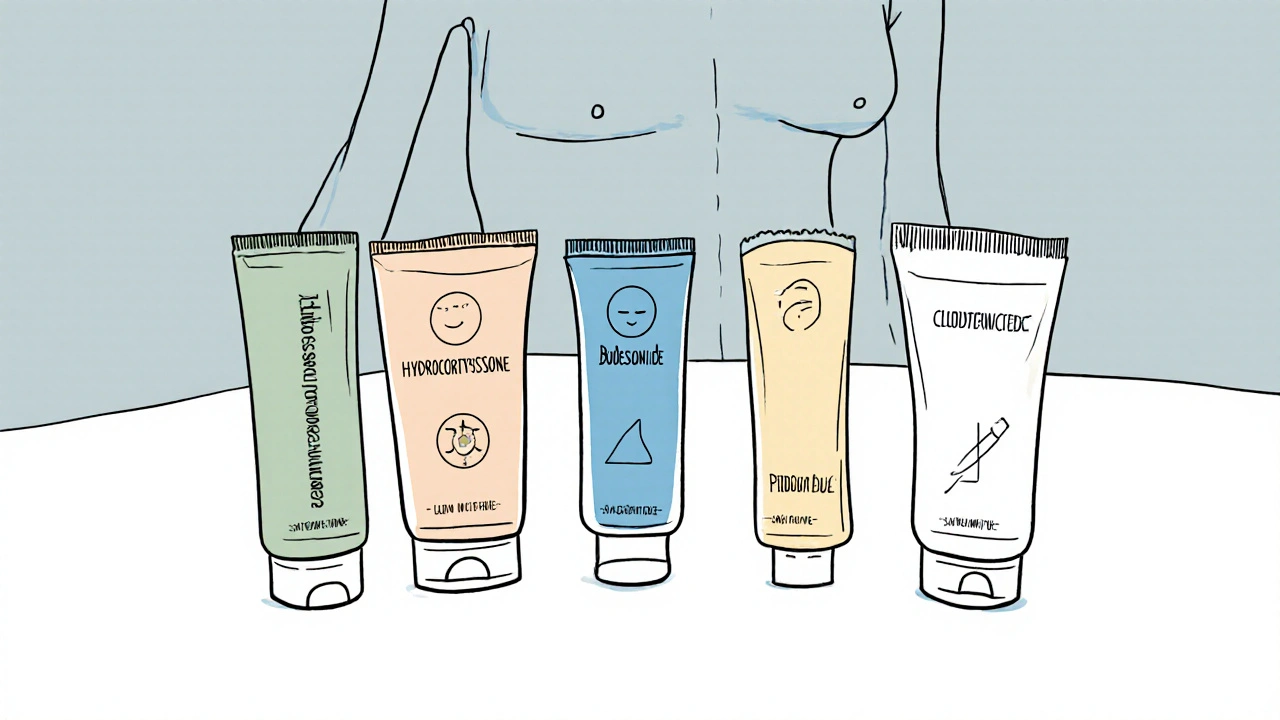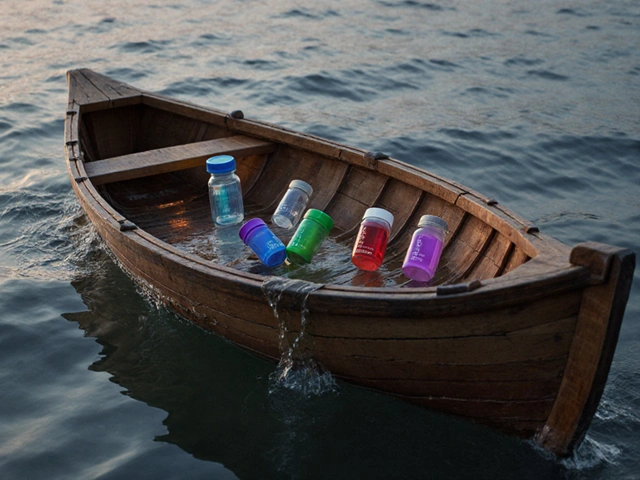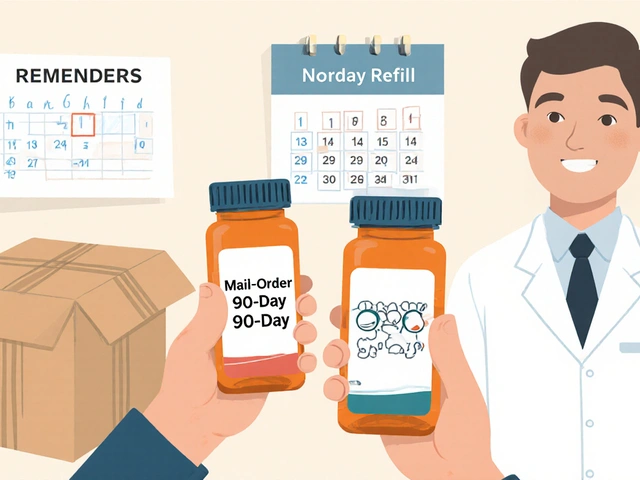Ever wondered if the steroid cream your doctor prescribed is the best fit for your skin condition? Aristocort (triamcinolone) is a household name in dermatology, but a slew of other corticosteroids sit on the market promising similar or even superior results. This guide breaks down what makes Aristocort tick, lines it up against the most common alternatives, and gives you a clear roadmap to pick the right option for your needs.
Quick Takeaways
- Aristocort is a mid‑potency synthetic corticosteroid ideal for inflammatory skin disorders like eczema and psoriasis.
- Betamethasone offers higher potency, making it better for thick‑skinned areas but carries a higher risk of skin thinning.
- Hydrocortisone is low‑potency, safe for delicate zones (face, folds) but may be insufficient for severe inflammation.
- Budesonide delivers strong anti‑inflammatory action with less systemic absorption, useful for sensitive patients.
- Clobetasol is ultra‑high potency; reserve it for short‑term, refractory cases under specialist supervision.
What Is Aristocort (Triamcinolone)?
Aristocort is a synthetic corticosteroid (triamcinolone acetonide) formulated as a cream, ointment, or lotion for topical use. Approved by the FDA in the 1970s, it quickly became a go‑to treatment for moderate inflammatory skin conditions because it balances potency with a relatively low side‑effect profile.
Triamcinolone works by binding to glucocorticoid receptors, dampening the release of inflammatory mediators like prostaglandins and cytokines. The result is reduced redness, swelling, and itching.
How Corticosteroids Work
Corticosteroid is a class of steroid hormones that modulate inflammation and immune responses. When applied topically, they penetrate the epidermis and enter keratinocytes, where they alter gene transcription. This leads to decreased formation of inflammatory chemicals and suppression of immune cell activity.
Potency varies widely across the class, ranging from hydrocortisone (low) to clobetasol (ultra‑high). Selecting the right potency hinges on the condition’s severity, skin thickness, and location.
Key Decision Criteria
- Potency Level - Determines how aggressively the drug reduces inflammation. Higher potency = stronger effect but higher risk of skin atrophy.
- Formulation - Creams absorb quickly, ointments stay longer, lotions spread easily over large areas.
- Target Condition - Eczema, psoriasis, contact dermatitis, and seborrheic dermatitis each respond best to specific potencies.
- Application Site - Face and intertriginous zones need low‑potency agents to avoid irritation.
- Side‑Effect Profile - Look for systemic absorption risk, skin thinning, striae, and potential HPA‑axis suppression.
Side‑Effect Snapshot
All topical steroids share a core set of possible adverse effects, but their frequency and severity differ:
- Skin thinning (atrophy)
- Telangiectasia (spider veins)
- Purpura (bruising)
- Hypopigmentation or hyperpigmentation
- Systemic effects - rare, but can include adrenal suppression with very high potency or prolonged use.
Comparison Table
| Drug | Potency (US classification) | Typical Formulations | Best‑Fit Conditions | Main Risks |
|---|---|---|---|---|
| Aristocort (Triamcinolone) | Mid‑potency (Class III) | Cream, ointment, lotion, spray | Eczema, psoriasis, allergic dermatitis | Moderate skin thinning with long‑term use |
| Betamethasone | High potency (Class II) | Cream, ointment, gel | Thick plaques, chronic psoriasis | Higher risk of atrophy, systemic absorption |
| Hydrocortisone | Low potency (Class VII) | Cream, ointment, lotion | Facial dermatitis, diaper rash, intertriginous areas | Often insufficient for moderate‑to‑severe flares |
| Budesonide | Mid‑high potency (Class II‑III) | Cream, gel | Atopic dermatitis, sensitive skin, patients needing lower systemic exposure | Potential for local irritation |
| Clobetasol propionate | Ultra‑high potency (Class I) | Cream, ointment, scalp solution | Severe plaque psoriasis, lichen planus, short‑term rescue therapy | Significant skin atrophy, systemic effects if overused |
Deep Dive into Each Alternative
Betamethasone
Betamethasone is a high‑potency synthetic glucocorticoid used for stubborn inflammatory dermatoses. Its stronger anti‑inflammatory action makes it a favorite for thick‑skinned plaques, but clinicians warn against using it on the face or groin without close monitoring.
Typical regimen: apply a thin layer once or twice daily for up to two weeks, then taper.
Hydrocortisone
Low‑potency Hydrocortisone is often the first‑line steroid for mild dermatitis and sensitive areas. It’s available over‑the‑counter in 1% formulations, making it accessible for occasional flare‑ups.
Because its anti‑inflammatory strength is modest, patients with moderate eczema may need to switch to a mid‑potency agent after a few days of little improvement.
Budesonide
Budesonide is a synthetic corticosteroid with high receptor affinity but limited systemic absorption. It’s especially useful for patients who have experienced side‑effects from other steroids or who have sensitive skin on the trunk and limbs.
Studies from 2023 show budesonide cream achieves comparable eczema scores to clobetasol while showing 30% lower cortisol suppression in laboratory tests.
Clobetasol propionate
At the top of the potency ladder sits Clobetasol propionate - an ultra‑high potency corticosteroid reserved for severe, refractory skin disease. Guidelines recommend limiting use to two‑week bursts, followed by a lower‑potency maintenance regimen.
Misuse can cause permanent skin thinning, so it’s rarely the first choice for chronic eczema.

When to Choose Aristocort vs. Alternatives
Below is a quick decision flow you can run through with your clinician:
- Assess severity: Mild → Hydrocortisone. Moderate → Aristocort or Budesonide. Severe → Betamethasone or Clobetasol (short‑term).
- Identify location: Face, folds, genitalia → Low‑potency (Hydrocortisone) or mid‑potency (Aristocort) with short courses. Thick palm/sole or scalp → Higher potency (Betamethasone, Clobetasol).
- Check patient history: Prior steroid atrophy? Opt for Budesonide or low‑potency alternatives. Systemic steroid history? Avoid ultra‑high potency.
- Consider formulation preference: Ointment for dry plaques, cream for moist lesions, lotion for large body areas.
In practice, many dermatologists start with Aristocort for most moderate cases because it offers a solid balance of efficacy and safety. If the response stalls after 7‑10 days, they step up to Betamethasone or down‑step to Hydrocortisone depending on the reaction.
Common Pitfalls & Pro Tips
- Over‑application: Applying more than a thin layer does NOT speed up healing; it only raises side‑effect risk.
- Ignoring tapering: Stopping a mid‑ or high‑potency steroid abruptly can trigger rebound inflammation. Reduce frequency gradually.
- Mixing products: Using multiple steroids simultaneously on the same area compounds potency and should be avoided.
- Sun exposure: Steroids thin the skin, making it more vulnerable to UV damage. Apply sunscreen if you’ll be outdoors.
- Pregnancy & breastfeeding: Discuss with your doctor; most topical corticosteroids are safe in low amounts, but high‑potency agents may require caution.
Frequently Asked Questions
How long can I safely use Aristocort?
For most adults, a continuous course of 2‑4 weeks is considered safe. If you need longer treatment, your clinician should schedule periodic breaks and reassess skin thickness.
Can I use Aristocort on my face?
Yes, but limit use to 1‑2 weeks and apply a thin layer. For very sensitive facial skin, a low‑potency option like Hydrocortisone 1% is often preferred.
What’s the main difference between Betamethasone and Aristocort?
Betamethasone is higher potency, so it works faster on thick plaques but carries more risk of skin thinning and systemic absorption. Aristocort sits in the middle, offering good efficacy with a smoother safety margin.
Is Budesonide better for children?
Budesonide’s lower systemic absorption makes it a strong candidate for pediatric eczema when a mid‑potency steroid is needed. Always follow pediatric dosing guidelines.
When should I switch to Clobetasol?
Reserve Clobetasol for severe, plaque‑type psoriasis or dermatitis that hasn’t responded to mid‑potency steroids after 2‑3 weeks. Use it as a short‑term rescue (max 2 weeks) and then taper.
Choosing the right corticosteroid is less about brand loyalty and more about matching potency, formulation, and safety to your specific skin challenge. By understanding how Aristocort stacks up against Betamethasone, Hydrocortisone, Budesonide, and Clobetasol, you-and your clinician-can craft a treatment plan that clears inflammation without compromising skin health.



Ivan Laney
October 21, 2025 AT 15:08When you look at the landscape of dermatologic therapy in America, it becomes crystal clear that we have the privilege of a pharmaceutical arsenal most nations can only dream of.
Aristocort, with its mid‑potency profile, stands as a testament to the ingenuity of American drug development, striking a balance that many foreign compounds fail to achieve.
Now, let us dissect the alternatives, not merely as chemical entities, but as strategic tools that should be wielded by clinicians who understand the stakes of skin health.
Betamethasone, for instance, wields higher potency, and while it may appear attractive for stubborn plaques, its propensity for atrophy mirrors the reckless abandon sometimes seen in off‑shore manufacturing.
Hydrocortisone, on the other hand, is the low‑key workhorse, safe for the delicate facial regions, yet its modest punch often leaves patients yearning for a more decisive resolution.
Budesonide brings a sophisticated pharmacokinetic profile, minimizing systemic absorption-a feature that aligns perfectly with the American emphasis on safety and precision.
Clobetasol, the ultra‑high potency titan, must be reserved for the most recalcitrant cases, and its misuse would be tantamount to squandering the very resources that keep our healthcare system competitive.
The decision matrix, therefore, hinges on potency, formulation, and patient‑specific factors, all of which are embedded within the regulatory framework that the United States upholds with rigor.
When a patient presents with moderate eczema on the trunk, the logical starting point is Aristocort, because it offers efficacy without the heavy hand of systemic side‑effects.
If after a solid ten‑day course the lesions persist, a modest escalation to Betamethasone can be justified, provided the clinician monitors for signs of thinning.
Conversely, in pediatric cases where the skin barrier is more fragile, Budesonide becomes the weapon of choice, reflecting our commitment to protecting the next generation.
The over‑application myth-that slathering more cream speeds healing-is a fallacy that the American public must discard alongside other health misinformation.
Tapering, too, is not an optional ritual but a disciplined protocol that prevents rebound inflammation, a principle echoed in the broader American ethos of strategic withdrawal.
Sun exposure while on steroids is a dangerous liaison; sunscreen, therefore, should be non‑negotiable, reinforcing the American tradition of proactive health measures.
In sum, the hierarchy of topical steroids is not a mere list of ingredients; it is a reflection of a system that values balance, safety, and the relentless pursuit of optimal skin health.
Kimberly Lloyd
October 21, 2025 AT 23:53Sounds like a solid roadmap-thanks for breaking it down!
Sakib Shaikh
October 22, 2025 AT 11:00Yo, the whole steroid thing is defnitely more complex than a simple "cream and go".
People think triamcinolone is just another over‑the‑counter miracle, but the chemistry behind it is like a miniature storm in your skin cells.
The way it binds the glucocorticoid receptors is basically a lock‑and‑key that shuts down the inflammation party.
And don’t even get me started on the formulation differences-cream versus ointment is not just a texture choice, it changes how deep the drug penetrates.
So if you’re slapping on a lotion thinking it’s safe, you might be missing out on the real power that a proper ointment can give you.
Bottom line: read the label, know the potency, and don’t be lazy about it.
Devendra Tripathi
October 22, 2025 AT 19:20While the patriotic flair is entertaining, the reality is that Aristocort isn’t the universal panacea some make it out to be.
Its mid‑potency can leave stubborn plaques untouched, forcing patients to jump straight to stronger steroids anyway.
Moreover, the assumption that American‑made drugs are inherently safer ignores the nuanced risk profiles each molecule carries.
Bottom line: clinicians should base choices on evidence, not on national pride.
Vivian Annastasia
October 23, 2025 AT 03:40Oh great, another fluffy summary, just what the world needed.
John Price
October 23, 2025 AT 14:46I usually stick with Aristocort for my eczema.
Works fine, no drama.
Nick M
October 23, 2025 AT 23:06Honestly, the whole thing feels like a pharma push.
They want you to chase the newest cream while the real cure is hidden.
Keep an eye on the board meetings.
eric smith
October 24, 2025 AT 10:13Nice try, Sakib, but let’s cut through the drama.
Triamcinolone’s mechanism isn’t some mystical sorcery; it’s textbook pharmacology.
If you’re looking for “wow” factor, the data on systemic absorption is all over the place.
Bottom line: stick to the facts, not the hype.
Erika Thonn
October 24, 2025 AT 18:33One could argue that the very act of categorizing steroids mirrors the human desire to impose order on chaos.
Yet, when we look at the table, the differences are as stark as night and day, even if our spelling sometimes betrays us.
For example, the potency class of budesonid is often mis‑typed, but its clinical relevance remains untouched.
In the end, the philosophy is simple: match the drug to the disease, not to the ego.
Remember, the skin is a canvas, and every cream is a brushstroke.
Ericka Suarez
October 25, 2025 AT 05:40Patriotic or not, the truth remains that Aristocort sits comfortably in the middle of the potency spectrum, a fact not to be ignored.
It is neither the feather‑light Hydrocortisone nor the bulldozer Clobetasol, but a balanced contender.
Those who dismiss it as “just average” overlook its versatility across body sites.
Remember, in medicine, balance often trumps extremes.
Jake Hayes
October 25, 2025 AT 14:00Betamethasone’s risk outweighs its benefits for most patients.
Stick with mid‑potency options.
parbat parbatzapada
October 26, 2025 AT 01:06Sure, the pharma narrative is compelling, but have you considered who profits from the endless cycle?
There’s always a back‑room discussion about market share.
Stay skeptical.
Casey Cloud
October 26, 2025 AT 09:26Overall, the guide does a good job laying out the strengths and weaknesses of each topical steroid.
It emphasizes the importance of potency matching and formulation choice without drowning the reader in jargon.
The side‑effect section is especially helpful for patients who worry about skin thinning.
Just remember to taper properly and protect the skin from sun exposure while on treatment.
In practice, start with a mid‑potency like Aristocort and adjust based on response.